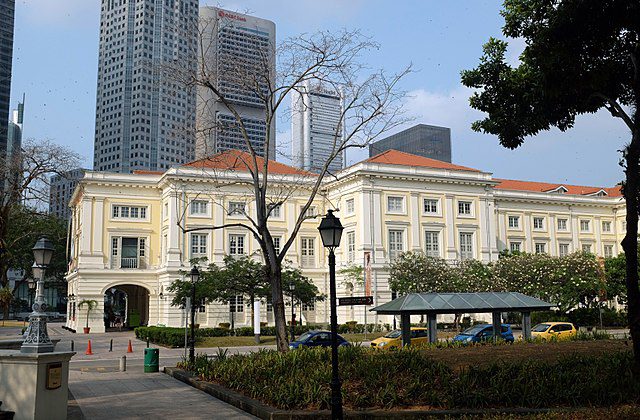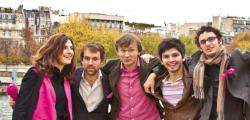
Asian Civilisations Museum by Wolfgang Holzem from Wikimedia Commons
Top 10 Outstanding Facts about Asian Civilisations Museum
The Asian Civilisations Museum (ACM) is Singapore’s lens to the view of Asian trade, religion, and culture. The museum explores historical shreds of evidence of the relationship between Asia and the world as well as within herself.
Singapore’s diverse ethnic groups trace their ancestry to China, Southeast Asia, South Asia, and West Asia. Hence, ACM centers on telling the story of these zones. Including their way of life, belief system, heritage, and evolution over the years.
Here are the top 10 fascinating realities of the Asian Civilisations Museum.
1. ACM’s first location was at the Old Tao Nan School

Asian Civilisations Museum at Old Tao Nan School by Sengkang from Wikimedia Commons
The Asian Civilisations Museum opened on 22 April 1997. At the time, they occupied the Old Tao Nan School building. The Armenian Street institution at its start focused on Chinese civilization exhibits.
2. Asian Civilisations Museum changed location in 2003
The museum relocated to the Empress Place Building, where it sits to date on 2 March 2003. It also expanded its collection to include more regions of Asia.
After the change of the museum’s physical address, the old property (Old Tao Nan School) was left to operate as its subsidiary. On 1 January 2006, it closed for renovations and reopened on 25 April 2008.
During its reopening, the Old Tao Nan School branch was renamed Peranakan Museum. The new name came with its specialization in Peranakan culture.
3. Asian Civilisations Museum rebranded in 2006

Asian Civilisations Museum, Empress Building by Jnzl’s Photos from Wikimedia Commons
On 16 September 2006, the museum adopted a new image with a different logo and slogan. The logo captured the magnificent view of the museum’s location by the Singapore River.
The slogan read “The Asian Civilisations Museum – Where Asian Cultures Come Alive.” The logo and slogan displayed the institution as a place for reflection as well as a facility bursting with activity and energy.
4. In 2013, the museum unveiled a new logo and slogan
The museum increased its collections to include more territory in Asia. Thus the new slogan represented the museum as a center for Asian history and culture. The slogan read, “Singapore’s Museum of Asia.”
The establishment was listed as the top museum in Singapore according to TripAdvisor’s Travellers’ Choice awards on 16 September 2014. The same awards ranked Asian Civilisations Museum ninth in Asia. The museum was the only Singapore museum to receive a position on the top ten list of Asia’s museums.
5. Asian Civilisations Museum is free to Singaporeans
All permanent galleries in Singapore are free to citizens and permanent residents (PRs). ACM is no exception so there are no admission fees for the same.
Singapore citizens and PRs only need to show their valid ID with their birthdate and they enjoy free entry. This applies to all the National Heritage Board’s national museums and heritage institutions in Singapore all year round.
6. The museum has organized its collections in three themes

Asian Civilisations Museum artifact (Opium bed and door frame) by Jacklee from Wikimedia Commons
Asian Civilisations Museum has three classifications of themes that guide its displays. They refer to them as levels, so level 1 is the Maritime Trade section. It is on the first floor and allows you to learn about the trade and maritime routes of the Asian communities spanning the 9th to the 20th century.
This category gives insights into Asian export art, the port cities involved, and how globalization took place in ancient years. One of the prominent collections in this segment is the Tang Shipwreck gallery.
Faith and belief are the second level or themes. It comprises the second-floor galleries that unravel the mystery of different Asia belief systems. Detailing their origin, how they spread throughout the continent and the trust and strength the locals put in these beliefs.
The Faith and belief level includes galleries like ancestors and rituals, ancient religions, and Scholars galleries. Christian art and Islamic art galleries are also part of this segment.
The third level is the Materials and design. It’s on the third floor and galleries here display authentic Asian art and craftsmanship through jewelry, fashion, and textiles as well as ceramics.
7. Asian Civilisations Museum organizes events to look out for
The museum goes beyond history narratives to include fun activities that are informative yet interesting to take part in. There are annual events like the River Nights. Which allows attendees to connect with the culture and various arts available at the museum.
There are also exhibitions of different nature that pop up from time to time. You can expect a wide range of exhibition genres such as fashion, art, religion, and trade to name a few.
8. There is a Café at the Asian Civilisations Museum
After you’re done exploring the galleries, you can walk into the Privé for some refreshments. The café offers a great ambiance for a peaceful time. You can relax to enjoy your meal as you overlook the Singapore River.
9. Asian Civilisations Museum has a restaurant within
This Chinese restaurant and bar at ACM are known as EMPRESS. It’s perfect for any event whether business lunches, social dinners, or name it, you will enjoy the environment, food, and drinks.
10. The Tang shipwreck gallery is significant to the museum

The Tang Shipwreck Gallery in the Asian Civilisations Museum by Jacklee from Wikimedia Commons
This gallery is on the first floor of the Asian Civilisations Museum. So, it might be a good first stop when you visit. It’s a reminisce of trade in the 9th century that allows you to visualize the events that befell a Middle Eastern ship ferrying valuable cargo.
The ship had onboard 60,000 pieces of Chinese ceramics, gold, and silver items. It sunk near Belitung island in the Java Sea south of Singapore. After its remains were recovered between the years 1998 and 99, they were given a permanent place at the Asian Civilisations Museum.
Asian Civilisations Museum has an APP you can download on your phone to enjoy a personal guide experience. It is loaded with audio tours that give insights into objects while the artistic videos create a real-time adventure of the museum’s artifacts.
The location of the museum by the Singapore River creates a serene surrounding for a memorable time. The gift shop at the Asian Civilisations Museum gives you a chance to take those memories with you. There are plenty of fine mementos for your trip to the Asian Civilisations Museum, at the gift shop. Be sure to grab one when you tour the museum.
Planning a trip to Paris ? Get ready !
These are Amazon’s best-selling travel products that you may need for coming to Paris.
Bookstore
- The best travel book : Rick Steves – Paris 2023 – Learn more here
- Fodor’s Paris 2024 – Learn more here
Travel Gear
- Venture Pal Lightweight Backpack – Learn more here
- Samsonite Winfield 2 28″ Luggage – Learn more here
- Swig Savvy’s Stainless Steel Insulated Water Bottle – Learn more here
Check Amazon’s best-seller list for the most popular travel accessories. We sometimes read this list just to find out what new travel products people are buying.










